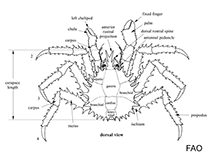Lithodes santolla (Molina, 1782)
Southern king crab| Native range | All suitable habitat | Point map | Year 2050 |

|
| This map was computer-generated and has not yet been reviewed. |
| Lithodes santolla AquaMaps Data sources: GBIF OBIS |
Изображение на Google | No image available for this species;
drawing shows typical species in Lithodidae.
Классификация / Names народные названия | синонимы | CoL | ITIS | WoRMS
Malacostraca | Decapoda | Lithodidae | Lithodinae
Environment: milieu / climate zone / пределы глубины / distribution range экология
; пределы глубины 0 - 700 m (ссылка 2686). Subtropical, preferred 9°C (ссылка 107945); 34°S - 57°S, 77°W - 51°W
Distribution страны | регионы FAO | Ecosystems | места находок | интродукции
Southeast Pacific and Southwest Atlantic: from Chile (Talcahuano to Cape Horn), Falkland Islands, Argentina and Uruguay. Subtropical and temperate.
Length at first maturity / Size / Weight / Возраст
половая зрелость: Lm ?, range 6 - 7.5 cm Max length : 19.0 cm CL самец/пол неопределен; (ссылка 93013); наибольший вес (опубликованные данные): 8.0 kg (ссылка 93013)
Life cycle and mating behavior половая зрелость | размножение | нерест | Eggs | Fecundity | Larvae
Основная ссылка
ссылки | координатор | соавторы
Arana, P.M.E. and M.A. Retamal 1999 Nueva distribución de Paralomis birsteini Macpherson, 1988 en aguas antárcticas (Anomura, Lithodidae, Lithodinae). Invest. Mar, Valparaíso 27:101-110. (ссылка 2676)
Статус Красного Списка МСОП
(ссылка 130435: Version 2025-1)
Статус СИТЕС (ссылка 108899)
CMS (ссылка 116361)
Угроза для людей
Использование человеком
рыболовство: коммерческий
FAO - рыболовство: landings | FishSource | Sea Around Us
инструменты
дополнительная информация
ресурсы в Интернет
BHL | BOLD Systems | CISTI | DiscoverLife | FAO(рыболовство: ; publication : search) | Fishipedia | GenBank (Геном, Нуклеотид) | GloBI | Gomexsi | Google Books | Google Scholar | Google | PubMed | Tree of Life | Wikipedia (Вперёд, поиск) | Zoological Record



